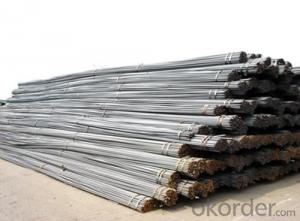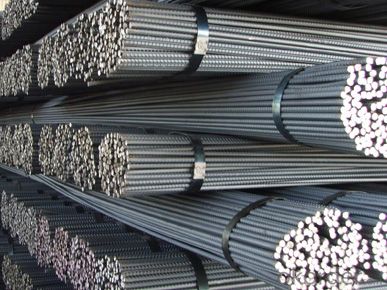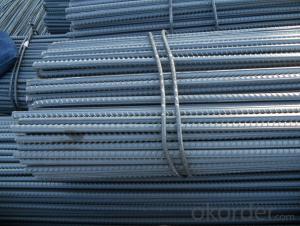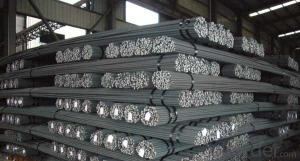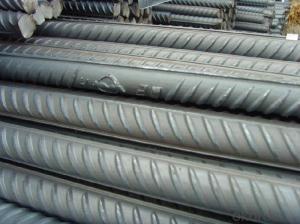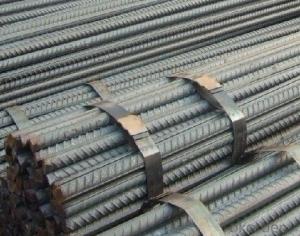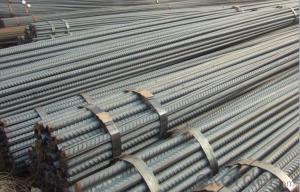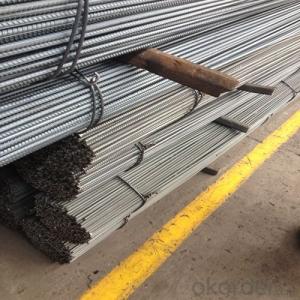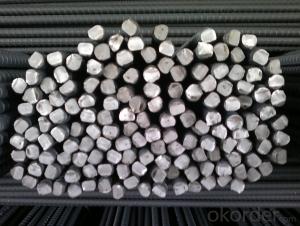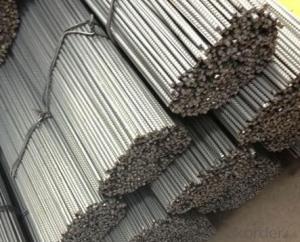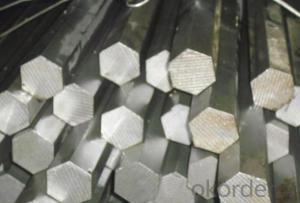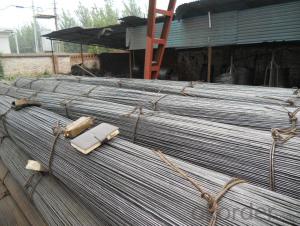Deformed Steel Bar Quality Guaranteed Thermo mechanically
- Loading Port:
- Tianjin
- Payment Terms:
- TT OR LC
- Min Order Qty:
- 28 m.t.
- Supply Capability:
- 20000 m.t./month
OKorder Service Pledge
OKorder Financial Service
You Might Also Like
Product Description
Deformed Reinforcing Steel Bar
Standard: AISI,ASTM,BS,DIN,BS,GB,JIS
Grade: HRB400/ HRB400E/ HRB500/ HRB500E/ Gr.40/ Gr.60/ B460B/ B500B
Diameter: 6mm-40mm
6mm,8mm rebar must be packaging in coil, ~2MT/coil
Length: 12m or 9m
Place of Origin: Hebei, China (Mainland)
Brand Name: Mammoth
Application: construction of houses, bridges, roads and other civil works,making Concrete
Packaging & Delivery
Packaging Details: | In bulk or Container according to the customer's require. |
Delivery Detail: | 15-30 days after L/C or prepayment. |
| THEORETICAL WEIGHT INDEX | ||
| SIZE(mm) | CUT AREA(CM2) | THEORETICAL WEIGHT(KG/M) |
| 8 | 0.503 | 0.395 |
| 9 | 0.636 | 0.5 |
| 10 | 0.79 | 0.62 |
| 12 | 1.13 | 0.89 |
| 14 | 1.54 | 1.21 |
| 16 | 2.01 | 1.58 |
| 18 | 2.55 | 2 |
| 20 | 3.14 | 2.47 |
| 22 | 3.8 | 2.98 |
| 25 | 4.91 | 3.85 |
| 28 | 6.16 | 4.83 |
| 32 | 8.04 | 6.31 |
♣ Mechanics Performance According to HRB335
Grade | Technical data of the original chemical composition(%) | |||||
C | Mn | Si | S | P | B | |
HRB335 | ≤0.25 | ≤1.60 | ≤0.80 | ≤0.045 | ≤0.045 | >0.0008 |
Physics capability | ||||||
Yield Strength(N/cm2) | Tensile Strength(N/cm2) | Elongation (%)
| ||||
≥335 | ≥490 | ≥16 | ||||
♣ Mechanics Performance According to HRB400
Grade | Technical data of the original chemical composition(%) | |||||
C | Mn | Si | S | P | V | |
HRB400 | ≤0.25 | ≤1.60 | ≤0.80 | ≤0.045 | ≤0.045 | 0.04-0.12 |
Physics capability | ||||||
Yield Strength(N/cm2) | Tensile Strength(N/cm2) | Elongation (%)
| ||||
≥400 | ≥570 | ≥14 | ||||
If you are interested in these kinds of products, please feel free to let me know, our best quotation will be sent for your information. Except steel bar, we also deal with steel pipe, deformed steel bar, angle steel, H and I beam, and channel. You are welcomed to visit our website www.tsruixiang.com.cn to know more about us.
And our products are mainly exported to Mild-east, South American, African, so please make assure of our quality and reputation. We sincerely hope we can cooperate in the near future.
Your any reply will be highly appreciated.

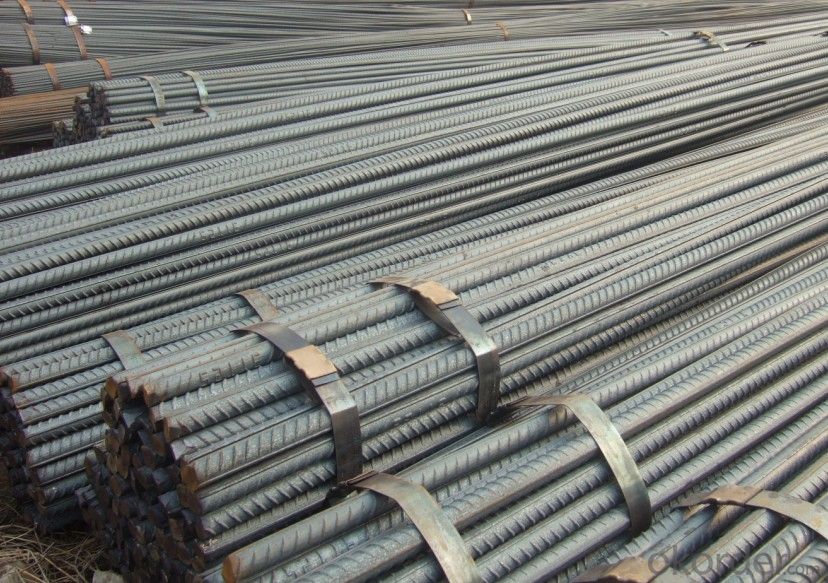
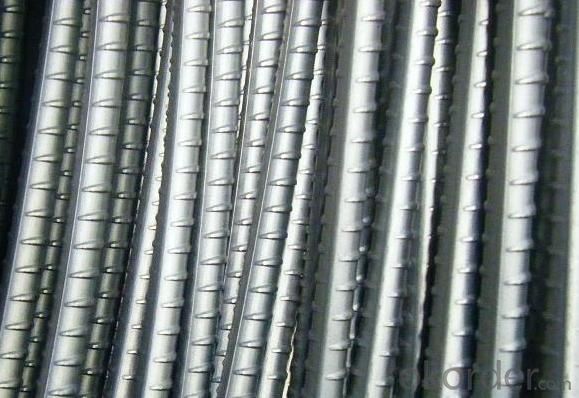
- Q: How do steel rebars impact the overall cost of a construction project?
- Steel rebars can have a significant impact on the overall cost of a construction project. While they add to the material costs, they also enhance the strength and durability of structures, reducing the need for future repairs or replacements. Additionally, steel rebars contribute to the overall efficiency and speed of construction, reducing labor costs and project timelines. Therefore, although they may increase upfront expenses, steel rebars can provide long-term cost savings and ensure the structural integrity of the project.
- Q: Can steel rebars be used in the construction of recreational facilities?
- Yes, steel rebars can be used in the construction of recreational facilities. Steel rebars provide structural strength and durability, making them suitable for various recreational structures such as sports arenas, swimming pools, and playgrounds. They are commonly used to reinforce concrete and ensure the safety and longevity of these facilities.
- Q: Are steel rebars suitable for reinforcement in tunnels?
- Yes, steel rebars are suitable for reinforcement in tunnels. Steel rebars have high tensile strength and provide excellent structural support, making them an ideal choice for reinforcing concrete in tunnels. They help enhance the structural integrity and durability of the tunnel, ensuring it can withstand the loads and stresses it will be subjected to during its lifespan.
- Q: What is the effect of steel rebars on the weight of a structure?
- Steel rebars have a significant effect on the weight of a structure, as they add additional mass to the overall construction.
- Q: What is the minimum cover for steel rebars in concrete?
- The minimum cover for steel rebars in concrete is typically specified by building codes and design standards. The exact minimum cover requirements can vary depending on factors such as the type of structure, the environmental conditions, and the desired level of durability. However, as a general guideline, the minimum cover for steel rebars in concrete is often in the range of 1.5 to 2 inches (38 to 50 millimeters) to provide sufficient protection against corrosion and ensure structural integrity.
- Q: How are steel rebars tested for quality assurance?
- Steel rebars are tested for quality assurance through various methods such as visual inspection, dimensional checks, and mechanical tests. Visual inspection involves examining the surface for any visible defects or irregularities. Dimensional checks ensure that the rebar meets the required size and shape specifications. Mechanical tests assess the strength, elasticity, and ductility of the rebars, including tensile and bending tests. These quality assurance tests help ensure that the steel rebars meet the necessary standards and are fit for their intended use in construction projects.
- Q: What are the different types of steel rebars used in railway bridges?
- There are several types of steel rebars used in railway bridges, each with their own specific characteristics and applications. Some of the common types include: 1. Carbon Steel Rebars: These are the most commonly used rebars in railway bridges. They are made of carbon steel and provide high tensile strength and excellent durability. Carbon steel rebars can withstand heavy loads and are suitable for various railway bridge applications. 2. Stainless Steel Rebars: Stainless steel rebars are highly resistant to corrosion and are used in railway bridges located in coastal or high humidity areas. They offer excellent long-term performance and are particularly beneficial in preventing rust and deterioration caused by exposure to moisture and salt. 3. Galvanized Steel Rebars: Galvanized steel rebars are coated with a layer of zinc to enhance their corrosion resistance. They are commonly used in railway bridges in areas with aggressive environmental conditions, such as industrial zones or areas prone to chemical exposure. The zinc coating provides an additional protective barrier, increasing the rebars' lifespan. 4. Epoxy-Coated Steel Rebars: Epoxy-coated rebars are coated with a layer of epoxy resin, providing enhanced corrosion protection. They are commonly used in railway bridges exposed to harsh environments, such as bridges located near chemical plants or in heavily polluted areas. The epoxy coating acts as a barrier against corrosion and extends the rebars' service life. 5. Prestressed Steel Rebars: Prestressed steel rebars are designed to withstand high tension loads. They are used in railway bridges that require additional strength and stability, particularly in areas with heavy train traffic or where long spans need to be covered. Prestressed rebars are tensioned before the concrete is poured, allowing them to counteract the tensile forces and prevent cracking or deformation. These are just a few examples of the different types of steel rebars used in railway bridges. The choice of rebar type depends on various factors, including the environmental conditions, load requirements, and design specifications of the bridge. It is essential to select the appropriate type of rebar to ensure the structural integrity and longevity of railway bridges.
- Q: What is the lifespan of a steel rebar in a concrete structure?
- The lifespan of a steel rebar in a concrete structure can vary depending on various factors. Generally, a properly designed and constructed concrete structure with steel reinforcement can have a lifespan of 50 to 100 years or more. One crucial factor influencing the lifespan is the quality of the concrete and its ability to protect the steel reinforcement from external elements. Concrete acts as a barrier, shielding the steel rebar from moisture, oxygen, and other potentially corrosive substances. However, if the concrete is of poor quality, contains excessive amounts of chloride or other aggressive chemicals, or is not properly cured, it can lead to the deterioration of the rebar and significantly reduce its lifespan. Another important factor is the exposure conditions to which the concrete structure is subjected. If the structure is located in a harsh environment with high levels of humidity, saltwater exposure, or industrial pollutants, it can accelerate the corrosion process and decrease the lifespan of the rebar. Proper maintenance and periodic inspection can also play a significant role in extending the lifespan of the steel rebar in a concrete structure. Regular inspections can help identify any signs of corrosion or deterioration early on, allowing for timely repairs or protective measures to be implemented. To enhance the lifespan of steel rebar, additional protective measures can be taken during construction, such as applying corrosion-resistant coatings or using stainless steel reinforcement. These measures can significantly extend the lifespan of the rebar and enhance the overall durability of the concrete structure. In summary, the lifespan of a steel rebar in a concrete structure can vary but can typically range from 50 to 100 years or more, provided that the concrete is of good quality, the exposure conditions are not too severe, and proper maintenance and protective measures are implemented.
- Q: Can steel rebars be used in port infrastructure construction?
- Yes, steel rebars can be used in port infrastructure construction. Steel rebars are commonly used in the construction industry, including for port infrastructure projects. Rebars provide strength and reinforcement to concrete structures, making them ideal for constructing durable and resilient port facilities. They help in reinforcing concrete slabs, beams, and columns, ensuring that the structures can withstand the heavy loads and constant exposure to water and other environmental factors in port areas. Additionally, steel rebars have high tensile strength, making them suitable for handling the dynamic forces experienced in port infrastructure such as wharves, piers, and docks. Overall, steel rebars are an essential component in the construction of robust and long-lasting port facilities.
- Q: How are steel rebars tested for quality and compliance?
- Steel rebars are tested for quality and compliance through various methods such as visual inspection, dimensional checks, chemical composition analysis, mechanical testing, and corrosion resistance evaluation. These tests ensure that the rebars meet the required standards, specifications, and performance criteria, ensuring their structural integrity and safety in construction projects.
Send your message to us
Deformed Steel Bar Quality Guaranteed Thermo mechanically
- Loading Port:
- Tianjin
- Payment Terms:
- TT OR LC
- Min Order Qty:
- 28 m.t.
- Supply Capability:
- 20000 m.t./month
OKorder Service Pledge
OKorder Financial Service
Similar products
Hot products
Hot Searches
Related keywords
